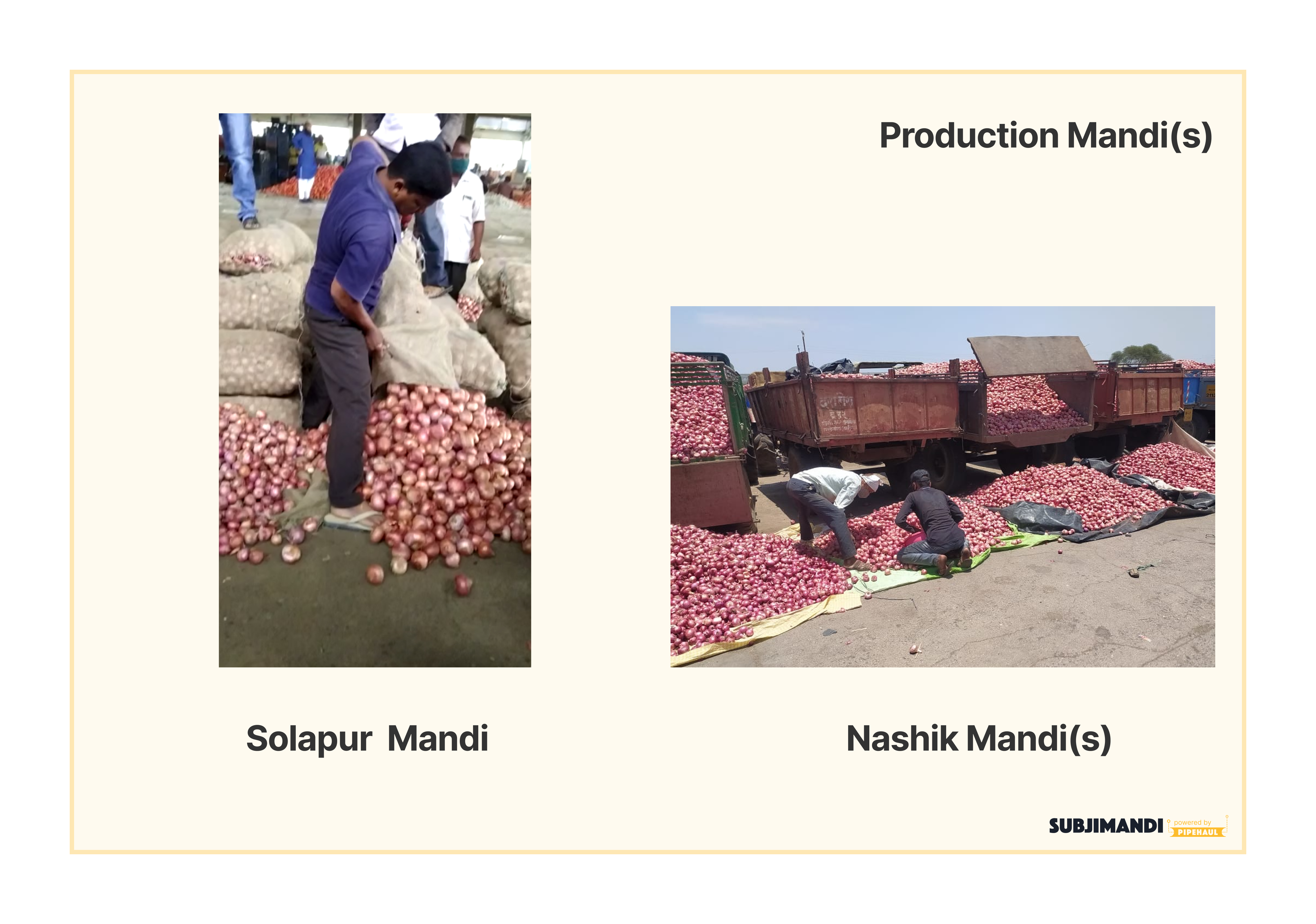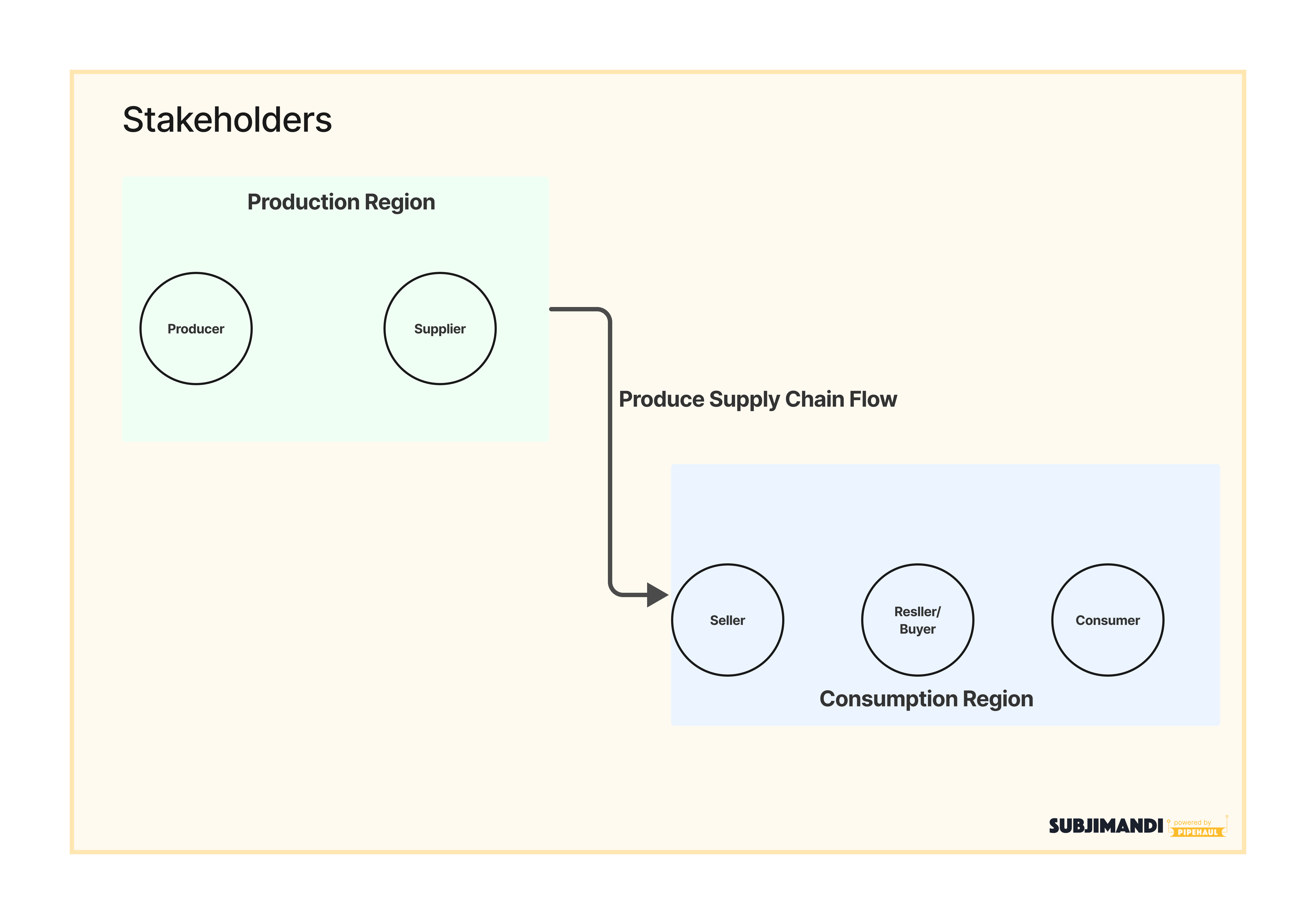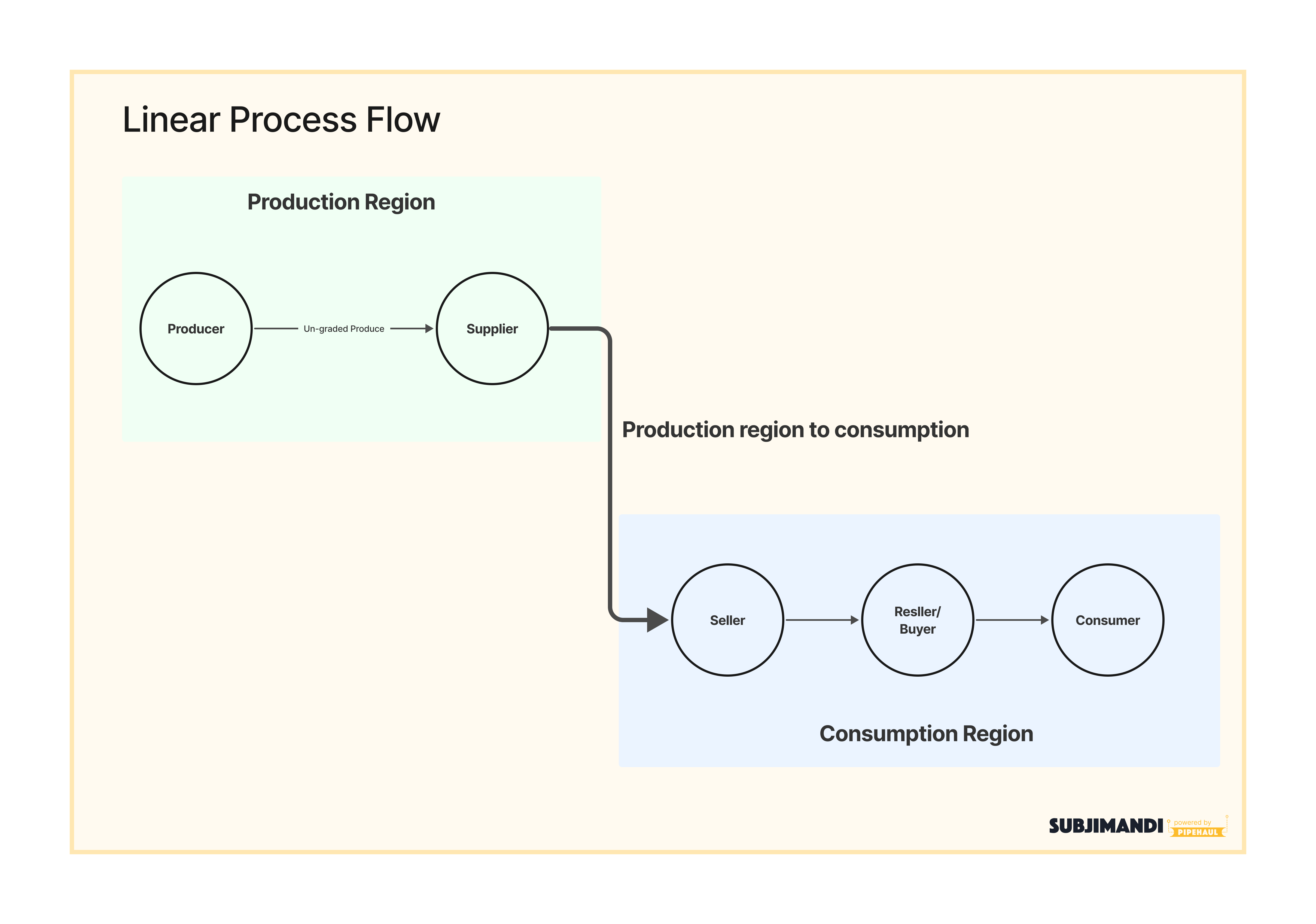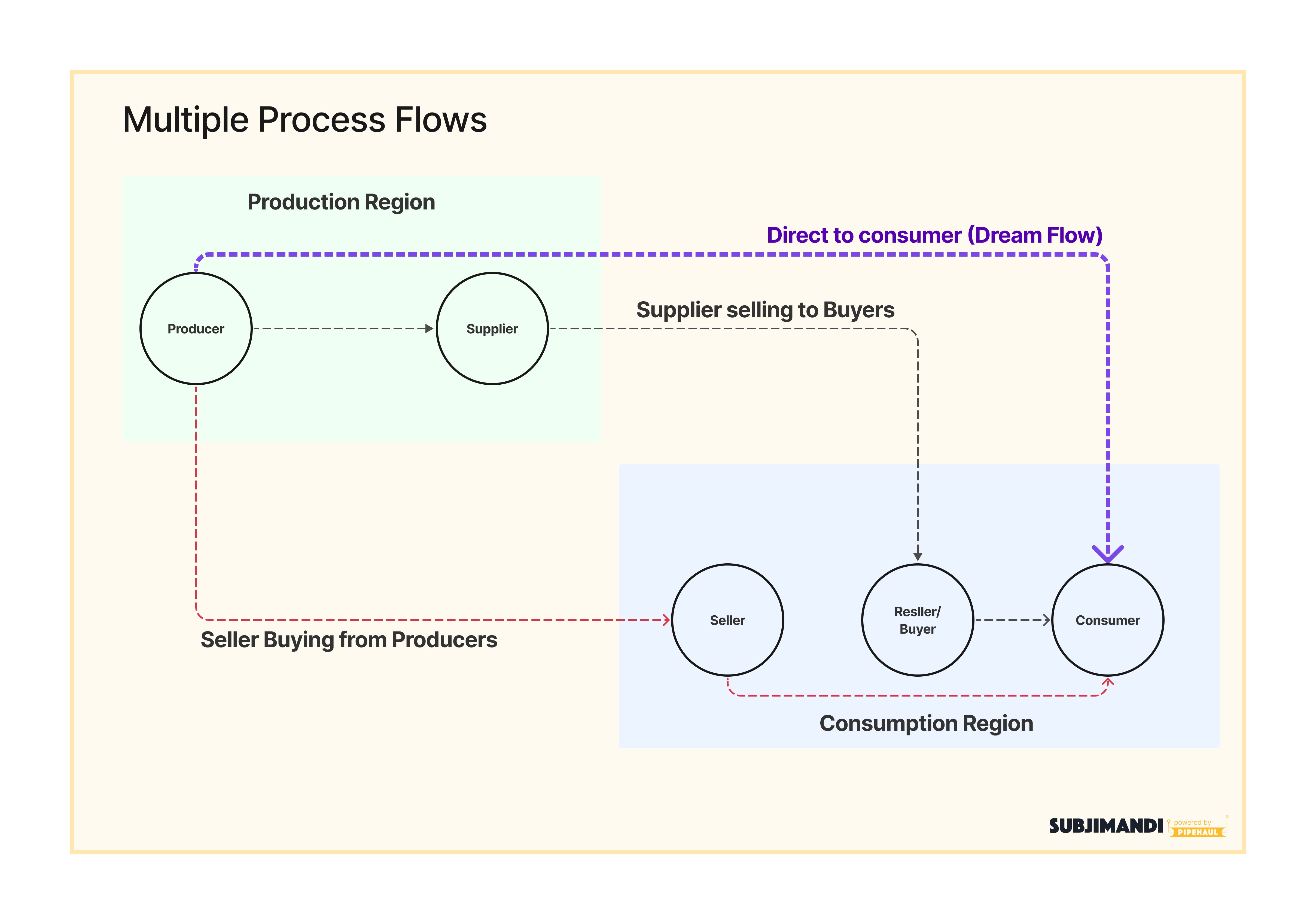Building a Marketplace within a Market
Written by

Vivek V.S
The idea of Subjimandi.app started with the basic premise of solving supply chain inefficiency in produce market.
By the time of our closure it spiralled over into masking the goal of building an alternate marketplace(previous post). This post is our attempt at mapping out the stakeholders that would be interacting with Subjimandi.app.
In any Mandi we have multiple stakeholders interacting, signalling and transacting to one another.
A version of this document was first published as an internal chapter of our company's book.
⚠️: Agri-space consists of multitudes. It has various angles, approaches and stakeholders involved. This space is subject to market, perception and political risk. This post is our own opinion from experience. Please take any writting from us for infotainment purposes only. This is not advice on how to solve problems, please consider doing your own research.
Produce Markets
We will use the term Marketplace and Mandi synonymously as both signify the same meaning.
The difference between a market and marketplace is well explained by Venky from Agribusiness Matters:
Marketplaces learn, Markets remembers. Marketplaces proposes, Markets disposes. Marketplaces are discontinuous, Markets are continuous. Markets control marketplaces by constraint and constancy. Marketplaces get all our attention, markets has all the power.
Attributing this to most of our off handed conversations about the marketplace/mandi we run.
"We don't need to sell Onion. There will be someone else who will, if we don't."
A market signifies the entire trade not just trade we do. Every time we pass on a procurement, there is an another avenue for the farmer(producer) to sell. Its similar for a buyer as well.
Defining the difference between Markets and Marketplaces.
Our eventual success as a marketplace is defined by the overall conditions of the market. As it is the market that will set our constraints and conditions.
For example, if there are no buyers for graded produce, we cannot create them. We will have to accept that. (fortunately, there were buyers for graded produce)
Similarly, we cannot sell at a higher delta than local mandi(s) where we are acquiring buyers. They will compare us to the other marketplaces(local mandi). We are constrained by the existing market structures and status quo trade practices.
Marketplace/Mandi are digital/physical entities that comprise of the rules the one operating them sets. We constantly see how auctioning changes from one Mandi to another one but across the mandi(s) the trade of Onion is happening on weight of produce calculated post the sale.
Overall Onion trade in India can be called as onion market, the process of sale can differ between marketplaces/mandi(s). Like, the Mandi sales of Onion is different in Nashik and Solapur.

Our Marketplace : Subjimandi.app
Coming back to the point Venky conveyed by mentioning 'power of markets'. Markets have all the power where as marketplaces are places with differentiating rules, value proposition and trade conditions that define a new approach to the market in order to gain some power.
Our reason behind positioning that there is 'no money' in produce for us as we approached the market with Subjimandi.app that is building an ecosystem of stakeholders with integrated logistics(Pipehaul).
We alone cannot do everything across a particular produce supply chain. We want local entities/stakeholders to become a part of it and build thriving businesses transacting through us.
The stakeholders to make our marketplace work are defined and categorised keeping the commodity that is being traded as the focus. In this spirit, this is our attempt to define the stakeholders that will be part of the produce trade. These definitions are not all complete. But, more as a starting point to identify the people/entities we will work with in this market.
Stakeholders:

-
Producer
-
They are predominantly going to provide us with the harvested produce. Making that produce standardised through grading and sorting is our responsibility.
-
Examples:
- Farmer / Producer
- FPO
- Co-operative society
-
-
Supplier
-
They will be providing us with produce in standardised manner. They are looking to sell through us directly to all consumption regions without particular focus or expertise on logistics or demand of produce.
-
Examples:
- Large Land Holding Farmers
- Local Traders
- FPO/Farmers
- Processing Plants
- Procurement Agencies of State bodies.
-
-
Seller
-
These are entities present in consumption region procuring produce on our marketplace for their reprocessing to specialised buyers and consumers.
-
They are more focused on buying standardised produce and add their value add in the reprocessing stage.
-
Produce shifts from being just produce to being packed produce or cut produce.
-
Examples :
- Vendors/Merchants who sell to buyers through us.
- Consumption region trades selling in Local Mandi(s)
- Pack-house suppliers who sell to supermarkets, Horeca and B2C delivery.
-
-
Buyer / Reseller
-
These can be organisations or people involved on the consumption side buying produce on our marketplace. The volume of trade is significantly lesser compared sellers.
-
Examples:
- E-commerce and Quick delivery companies.
- Physical Retail stores
- Street Vendors and Kirana stores.
- Weekly Market stalls.
- Horeca (Hotels , Restaurants and Catering)
-
-
Consumer
-
Consumer represents people who consume the produce we procure from the producers. We don't sell to them directly but knowing about them is pivotal to the functioning of the entire produce supply chain.
-
Understanding them will help us ensure tighter feedback loops to our producers and inadvertently better produce.
-
Bringing awareness of produce to consumers ensures there will be normalisation of cost of produce for consumers to be pegged to the value produce for themselves.
-
We believe, the more aware and empowered the consumers become, it will lead them to acknowledge the cost that they need to spend for the produce they want.
-
This is contrasting to the current nature where the price of the produce is set on a comparative or purchase value of produce.
-
Example:
- Average joe just like you and me.
-
Summing it Up
The existing marketplaces are designed to optimise for one set of trade between one pair of stakeholders.
In produce markets, flow of trade need not happen linearly or sequentially. Let me use the help of Illustration to make this point.

- Linear Process Flow is the logical nature of the stakeholder definition. But that is not how real environment works. So, we are not insisting the trade of produce needs to flow in one certain way. These definitions as already mentioned, gives us an anchor to start segmenting people we interact in the market with respect to our marketplace.
- A single person can be a producer for one commodity and a consumer for an another commodity.

- In multiple process flows there will be a stakeholder that will be skipped and the other stakeholders take up the role. Few of the possibilities are laid out in the info-graph.
- The ultimate flow, The Dream Flow. It is the utopia we are aiming for in produce markets. We know why it is not likely possible as what the consumers want and how they want in produce is different to how the producers grow.
Yet, There is no harm in striving to achieve the utopia and be optimistic about our chances. Few of the building blocks that are requisite for this flow to happen is providing feedback loops to both consumers and producers. But the most important step to make any of this happen is building a common understanding of what is traded among all stakeholders. This is why "We grade, you trade" became the the tagline of Subjimandi.app.
A special thanks to Venky and his newsletter for helping us define the difference between markets and marketplaces(🔒). You should also subscribe to his newsletter if you want to keep yourself updated and aware of the hard questions that Indian agri-space is looking to answer. (Subscribe here)
